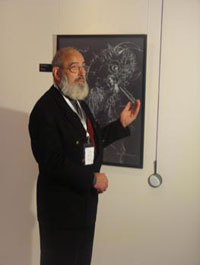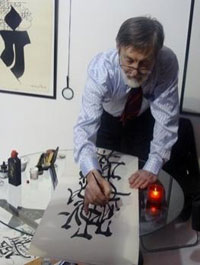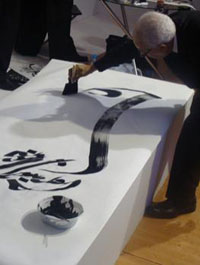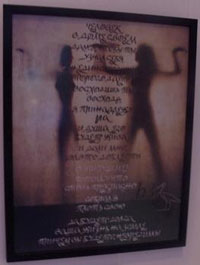Opening of the 2nd International Exhibition of Calligraphy

From October 14th till November 14th, 2009, Sokolniki Exhibition and Culture Centre will host the 2nd International Exhibition of Calligraphy. The exhibition was officially opened on October 14th.
According to Vremya Soyuza (the Union Times) correspondent, the official opening ceremony was attended by officials from the Moscow Patriarchate, the Mufti Council of Russia, and the Chief Rabbinate of Russia; representatives of cultural centres, museums, education centres, and embassies; businessmen, collectors, art experts, and critics.
The exhibition in Moscow will represent masterpieces from thirty countries: Russia, Ukraine, Belarus, Israel, USA, Japan, China, Iran, France, Italy, Germany, Australia, Brazil, etc.
This year, the 2nd International Exhibition of Calligraphy is located in three pavilions. The largest part of the exhibition is situated in a two-storey mobile pavilion which is entirely unique for Russia.
For the first time ever the exhibition displays a World Famous Mezuzah, a masterpiece of sacral calligraphy listed into the Guinness World Records, a sacred Hebrew scroll written on parchment by a renowned Jerusalem calligrapher Abraham Hersh-Borshevsky. The visitors will also see the unique works of art: a draft copy of the illustrated handwritten copy of the Anthem of the Russian Federation, the present to President Dmitry Medvedev from Italian Prime-Minister Silvio Berlusconi; the unique handwritten copy of the Constitution of the Russian Federation, the Decalogue, the unique calligraphy piece Calligraphy On a Wing Of a Fly, the handwritten Charter of the National Union of Calligraphers, etc.
The 2nd International Exhibition of Calligraphy is held under the auspices of the Commission of the Russian Federation for UNESCO and the Ministry of Culture of the Russian Federation.

Professor Pavel Semchenko, calligrapher and artist, Spiritual Renaissance prize winner shared his impressions about the exhibition with the Union Times correspondent, “The International Exhibition of Calligraphy is a unique cultural event, the only hope for a spiritual union of Russia and Belarus. Calligraphic art is a holy phenomenon. The works demonstrated at the show prove we haven’t lost our links with the past. It is not a chance thing the Exhibition has aroused interest among the chief religious leaders.”
The exposition of the Contemporary Museum of Calligraphy includes unique specimens of Slavonic and West-European artistic writing, works of art by the masters of Arabic and Hebrew calligraphy and the masterpieces of ancient Japanese and Chinese writing. There is something divine about the whole thing, something spiritual, something, which can be traced in each correction on the canvas. As a rule, a calligrapher creates in one go. Her anxiety and emotion are reflected in her works. Calligraphic items are impregnated with various meanings and messages of religious, spiritual, or philosophical nature. We interpret them and attach a meaning of our own to them seeking the truth behind all those curves and curls.
“In the era of computerization the interest for the graphic form of the language cannot help but gladden us,” Pyotr Semchenko said.
The opening ceremony featured master-classes by illustrious contemporary calligraphers. The art of beautiful handwriting was demonstrated by Yadollah Kaboli, a renowned Iranian artist; Nja Mahdaoui, the patriarch of the world calligraphy, artist of UNESCO and Arab Sheikhs; and Pyotr Chobitko, President of the National Union of Calligraphers, etc.
The master classes on calligraphy will be given by Massimo Polello, President of Turin calligraphers' guild Dal Segno alla Scrittura; Barbara Calzolari, calligrapher of Pope Benedict XVI; and Chen Wenfu, continuator of a great dynasty of Chinese calligraphers, member of the Chinese Scientific Union of Antithetical Couplets.
Photo by author. Above: Belarus master Pavel Semchenko, Russian calligrapher Pyotr Chobitko.
Below from left to right: Nja Mahdaoui, calligrapher from Iran; Twin, a work by Dmitry Petrovsky from the Ancient Egypt Words and Images series.


Source: Vremya Soyuza (The Union Times, vreso.ru)
Back to listCalligraphy is a remedy and mental gymnastics.



